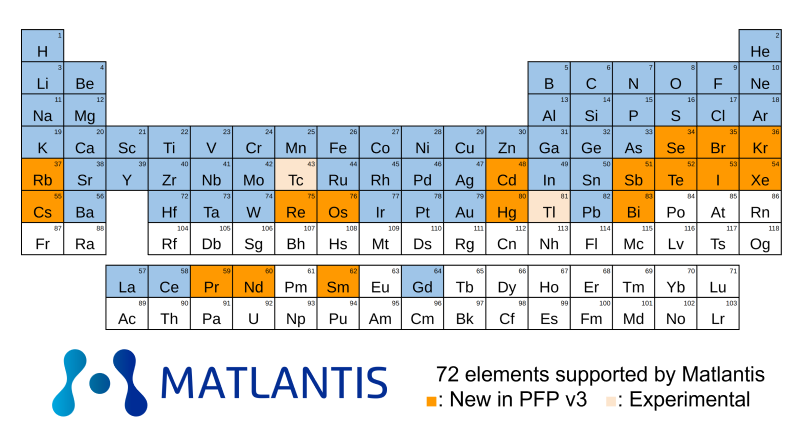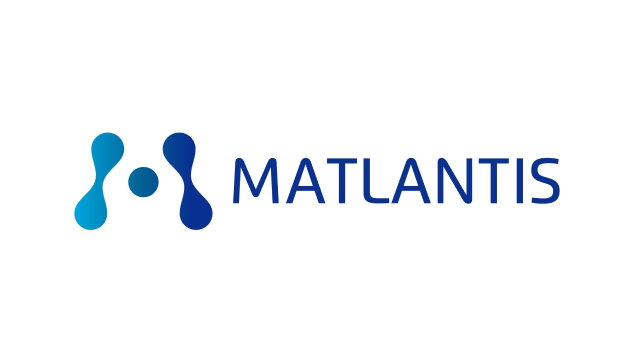News
Preferred Networks and ENEOS Announce Major Update to Core Technology Powering Matlantis Atomistic Simulator
New PFP neural network potential now covers 72 elements, over 99.99% of all materials on earth
2022.09.16
TOKYO – September 16, 2022 – Preferred Networks, Inc. (PFN) and ENEOS Corporation (ENEOS) today released the new version 3 of Preferred Potential (PFP)*1, the core technology powering the Matlantis™ universal atomistic simulator that was co-developed by the two companies. Now powered by PFP v3, Matlantis supports 72 elements (previously 55) with improved simulation accuracy, further accelerating its users’ materials discovery efforts.

To develop highly competitive new materials, it is essential to predict the material’s atomic structure, density, and bonding state accurately as these factors determine its properties, and the prediction needs to cover various elements. To continue improving Matlantis’s simulation accuracy and versatility, PFN has taken a unique approach to build PFP’s training data and continuously enhanced its deep learning model. The computational resources that PFN has used to develop PFP are now equivalent to what a single graphic processing unit (GPU) would need 1,144 years of computation time. The total number of PFP’s datasets has reached 22 million, 2.2 times more than when its first version was released. The companies further enhanced PFP’s accuracy and developed its applications based on ENEOS’s extensive knowledge in chemical technology.
In addition, the companies have been taking a multifaceted approach in developing and testing Matlantis by incorporating user feedback collected by Preferred Computational Chemistry (PFCC), the joint venture between PFN and ENEOS for the sale of Matlantis.
With the new update, Matlantis supports 72 elements which cover a majority of the periodic table and comprise over 99.99% of all materials on the earth*2.
The newly supported elements include rare earth (praseodymium, neodymium and samarium) that are used for exhaust gas catalysts, hydrogen-absorbing alloy and other purposes as well as halogen (bromine and iodine) that are seen as promising candidates for next-generation solar cells. PFN and ENEOS expect these additions will potentially help companies reduce greenhouse gas and develop new sources of clean energy, eventually contributing to achieving the UN’s Sustainable Development Goal 7: Ensure access to affordable, reliable, sustainable and modern energy for all.
PFN and ENEOS also confirmed that PFP’s new version reproduces chemical reactions and atomic structures at a higher accuracy than its previous version, resulting in an increased number of properties predicted before physically developing the material. One example of such properties is density of organic molecules in liquids; the companies have confirmed that their simulation reproduced what experiments showed at a high accuracy.
PFN, ENEOS and PFCC will continue developing Matlantis and PFP to help companies discover innovative materials for a sustainable future.
About Matlantis
Jointly developed by PFN and ENEOS, Matlantis is a universal atomistic simulator that supports large-scale material discovery by reproducing new materials’ behavior at an atomic level on the computer. PFN and ENEOS have incorporated a deep learning model into a conventional physical simulator to increase the simulation speed by tens of thousands of times and to support a wide variety of materials.
Launched in July 2021 as a cloud-based software-as-a-service, Matlantis has been used by 41 companies and institutions as of September 1, 2022. Matlantis has been used for discovering various materials including catalysts, batteries, semiconductors, alloys, lubricants, ceramics and chemicals.
For more information, please visit: https://matlantis.com
*Note 1: PFP is the name of the unique neural network potential (NNP) that PFN and ENEOS co-developed for universal atomistic simulation for materials discovery using deep learning. An NNP expresses molecular dynamics using a neural network. Source: S. Takamoto, et al. Nat Commun 13, 2991 (2022). doi: 10.1038/s41467-022-30687-9
*Note 2: The 72 elements comprise over 99.9969% of the total mass of all elements in the earth’s crust. Source: CRC Handbook of Chemistry and Physics, 97th edition (2016–2017), ss. 14-17



